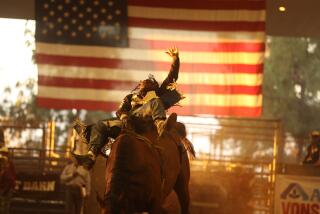Hot-Rod Lover’s Heaven
- Share via
For anyone with a weakness for old flames, the Grand National Roadster Show lights a fire. Visiting this granddaddy of hot-rod shows is a rite of passage for those whose passions run to American hot rods and custom cars and motorcycles.
What started as the Oakland Roadster Show in 1950 showcased 270 vehicles last weekend in San Mateo, where it landed several years ago after outgrowing its longtime Oakland digs and changing its name.
But while it’s been rebadged, the four-day event that ended Sunday remains a major love-in for any hot-rodder worth his--or her--pinstripes. That’s right. Her.
Today’s hot-rod and custom-car scene, which generates sales of products and services in excess of $600 million a year, according to the Specialty Equipment Market Assn. in Diamond Bar, is no longer just for overgrown boys in greasy blue jeans and grimy T-shirts.
“I just love all the fancy paint jobs, the chrome and the fancy engines,” said Michelle Pena, who was visiting the show with her father.
The 31-year-old financial services worker owns a 1967 Chevrolet Chevelle Super Sport with a 396-cubic-inch engine.
“I’ve always loved the look of muscle cars. When I see one, I think to myself, it must have been such a good time back then,” she said. Participating in the hot-rod scene is a family affair for the Penas, Michelle said. “We do it for the friendship and the love of cars. Our club meetings are once a week and we go on cruises and picnics.”
Her father, Hank Pena, is a retired South San Francisco painter and member of the Golden State Rods car club. He drives a red 1931 Chevrolet five-window coupe and said he is drawn to hot-rodding by the brilliant designs and incredible attention to detail lavished on the steel and fiberglass dream machines.
“There’s a magic to them,” he said. “The old cars were each unique.”
And hot-rodders--as opposed to vintage car restorers--elaborate on their vehicles’ individuality.
Owners customize their cars from mild, perhaps adding an extra set of taillights or having custom pinstripes painted on, to wild--grafting on headlights, quarter panels and more powerful engines.
A case in point at the show was Steve and Colette Sbelgio’s stunning black ’34 Ford. The Whittier couple’s head-turner sports gorgeous orange flames and boasts state-of-the-art mechanicals: a 2000 Corvette V-8 engine mated to an electronically controlled automatic transmission.
Hot-rodding has benefited from a dual convergence--of antique cars and modern power-train technologies, and of enthusiasts aging into their prime earning years in the midst of a robust economy.
Many participants were at the show because they now can afford the cars they lusted after as teenagers, said Bob Kehoe, spokesman for Dan Cyr Enterprises, the latest promoter of the Grand National.
That hasn’t been lost on American auto makers, which have taken their own detours down memory lane, as witnessed by Chrysler’s hot-selling PT Cruiser and Ford’s new Thunderbird. And General Motor Corp.’s Buick division had its latest retro concept car, the Blackhawk, on display at the Grand National this year.
Hot-rodders seem to have more colors than Crayola has Crayons. The hot paint these days is called color-shift--it changes color depending on the angle at which it’s viewed.
But even though professionally built rods can easily cost $75,000, it doesn’t take a millionaire to enjoy hot-rodding.
“You can get yourself a nice car for $5,000. You don’t even have to have a car to be involved,” said Michelle Pena, who drives her prized Super Sport twice a week or so. Her father agreed. “When you walk around here,” he said of the roadster show, “you never see a sad face.”






